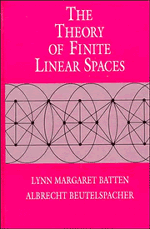Book contents
- Frontmatter
- Contents
- In memory of PAUL de WITTE 1931–1980
- Preface
- 1 The essentials
- 2 Complementation
- 3 Line sizes
- 4 Semiaffine linear spaces
- 5 Semiaffine linear spaces with large order
- 6 Linear spaces with few lines
- 7 d-Dimensional linear spaces
- 8 Group action on linear spaces
- Appendix
- Notation index
- Subject index
5 - Semiaffine linear spaces with large order
Published online by Cambridge University Press: 05 May 2010
- Frontmatter
- Contents
- In memory of PAUL de WITTE 1931–1980
- Preface
- 1 The essentials
- 2 Complementation
- 3 Line sizes
- 4 Semiaffine linear spaces
- 5 Semiaffine linear spaces with large order
- 6 Linear spaces with few lines
- 7 d-Dimensional linear spaces
- 8 Group action on linear spaces
- Appendix
- Notation index
- Subject index
Summary
Introduction
In this chapter we consider semiaffine linear spaces of a much more general nature than in the previous chapter. Also, our methods are quite different. We take a somewhat graph-theoretic approach, using terminology and some basic notions from that area. For us, the vertices of the graph are the lines of the linear space.
Our principle result (Theorem 5.3.3) can be interpreted as follows. If the order n of the linear space S is large enough with respect to the difference between the maximum point degree and the minimum line degree in S, then S embeds in a projective plane of order n. This chapter is based on Beutelspacher and Metsch (1986, 1987).
Our first result is a very general one. The proof is broken into several stages by using propositions. For lines L and H, we denote by m(L,H) the number of lines missing both L and H.
Theorem 5.1.1. Let S = (p,ℒ) be a linear space. Suppose there are a line H and integers a, c, d, e, n and x with the following properties.
(1) The degree of H is n + 1 − d > 0.
(2) The number of lines missing H is nd + x > 0.
(3) For every line L missing H we have n − 1 + a ≤ m(L, H) ≤ n − 1 + c.
(4) For any two intersecting lines L1 L2 missing H, we have m(L1,L2) ≤ e + 1.
[…]
- Type
- Chapter
- Information
- The Theory of Finite Linear SpacesCombinatorics of Points and Lines, pp. 96 - 118Publisher: Cambridge University PressPrint publication year: 1993

